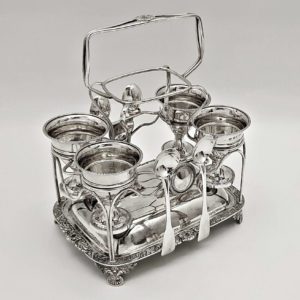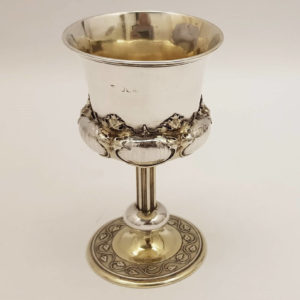William Bateman
William Bateman was the grandson of Hester Bateman.
Hester Bateman (1708–1794) is probably the most well known of all English lady silversmiths and her work is highly collectible. She married the goldsmith John Bateman in 1732 and together they worked a small silversmith business. Following the death of her husband in 1760 she successfully ran her family business for thirty years and was succeeded in turn by her sons, grandson and great-grandson and the Bateman family silversmithing company lasted until the middle of the nineteenth century.
Hester had at least five children – Jonathan, Peter, probably John (who may have been connected with the business, although he is only recorded as a watch and clock-maker), Letitia (who married Richard Clarke), and Ann. Only Peter, Letitia, and Ann were still living at the time of Hester’s death. Hester registered her mark at Goldsmith’s Hall ‘April 16, 1761, as Hester Bateman in Bunnhill Row and this mark was used until 1790. Hester died in 1794.
Her sons PETER BATEMAN and JOHN BATEMAN registered their mark in 1790. This partnership was of short duration as Jonathan, who married Ann Downlinff, died in 1791.
In 1791 the mark was changed to PETER and ANN BATEMAN, Jonathan’s widow.
In 1800 was registered the mark of PETER BATEMAN, ANN BATEMAN and WILLIAM (I) BATEMAN. William Bateman was the son of Jonathan and Ann Bateman who in 1800 entered in partnership with his uncle Peter and his mother Ann.
In 1805, after the retirement of Ann, was registered the new mark of PETER BATEMAN and WILLIAM (I) BATEMAN.
From 1815 to 1840 WILLIAM (I) BATEMAN was registered alone.
From 1839 to 1843 was registered the mark of WILLIAM (II) BATEMAN (son of William I) & DANIELL BALL.
William Bateman
William Bateman was the grandson of Hester Bateman.
Hester Bateman (1708–1794) is probably the most well known of all English lady silversmiths and her work is highly collectible. She married the goldsmith John Bateman in 1732 and together they worked a small silversmith business. Following the death of her husband in 1760 she successfully ran her family business for thirty years and was succeeded in turn by her sons, grandson and great-grandson and the Bateman family silversmithing company lasted until the middle of the nineteenth century.
Hester had at least five children – Jonathan, Peter, probably John (who may have been connected with the business, although he is only recorded as a watch and clock-maker), Letitia (who married Richard Clarke), and Ann. Only Peter, Letitia, and Ann were still living at the time of Hester’s death. Hester registered her mark at Goldsmith’s Hall ‘April 16, 1761, as Hester Bateman in Bunnhill Row and this mark was used until 1790. Hester died in 1794.
Her sons PETER BATEMAN and JOHN BATEMAN registered their mark in 1790. This partnership was of short duration as Jonathan, who married Ann Downlinff, died in 1791.
In 1791 the mark was changed to PETER and ANN BATEMAN, Jonathan’s widow.
In 1800 was registered the mark of PETER BATEMAN, ANN BATEMAN and WILLIAM (I) BATEMAN. William Bateman was the son of Jonathan and Ann Bateman who in 1800 entered in partnership with his uncle Peter and his mother Ann.
In 1805, after the retirement of Ann, was registered the new mark of PETER BATEMAN and WILLIAM (I) BATEMAN.
From 1815 to 1840 WILLIAM (I) BATEMAN was registered alone.
From 1839 to 1843 was registered the mark of WILLIAM (II) BATEMAN (son of William I) & DANIELL BALL.
-


1818
William Bateman
9552 George III Antique Silver Egg Cruet
Sold
A decorative antique sterling silver egg frame containing 4 egg cups and spoons. Typical ornament of the period. Weight 599 grams, 19.2 troy ounces. Total height 21cm (to top of handle). Base of frame 17.5 x 13.5cm. London 1818. Maker William Bateman I. All pieces same matching date and maker.
-


1834
William Bateman
9618 William IV Antique Silver Goblet
Sold
An excellent quality antique sterling silver wine cup with shaped bellied form and applied vine leaf decoration. Bright partial gilding to the exterior. Gilt interior. Small size. Contains 120 ml. Weight 170 grams, 1.4 troy ounces. Height 13 cm. Diameter of top 7.5 cm. London 1834. Maker William Bateman II.